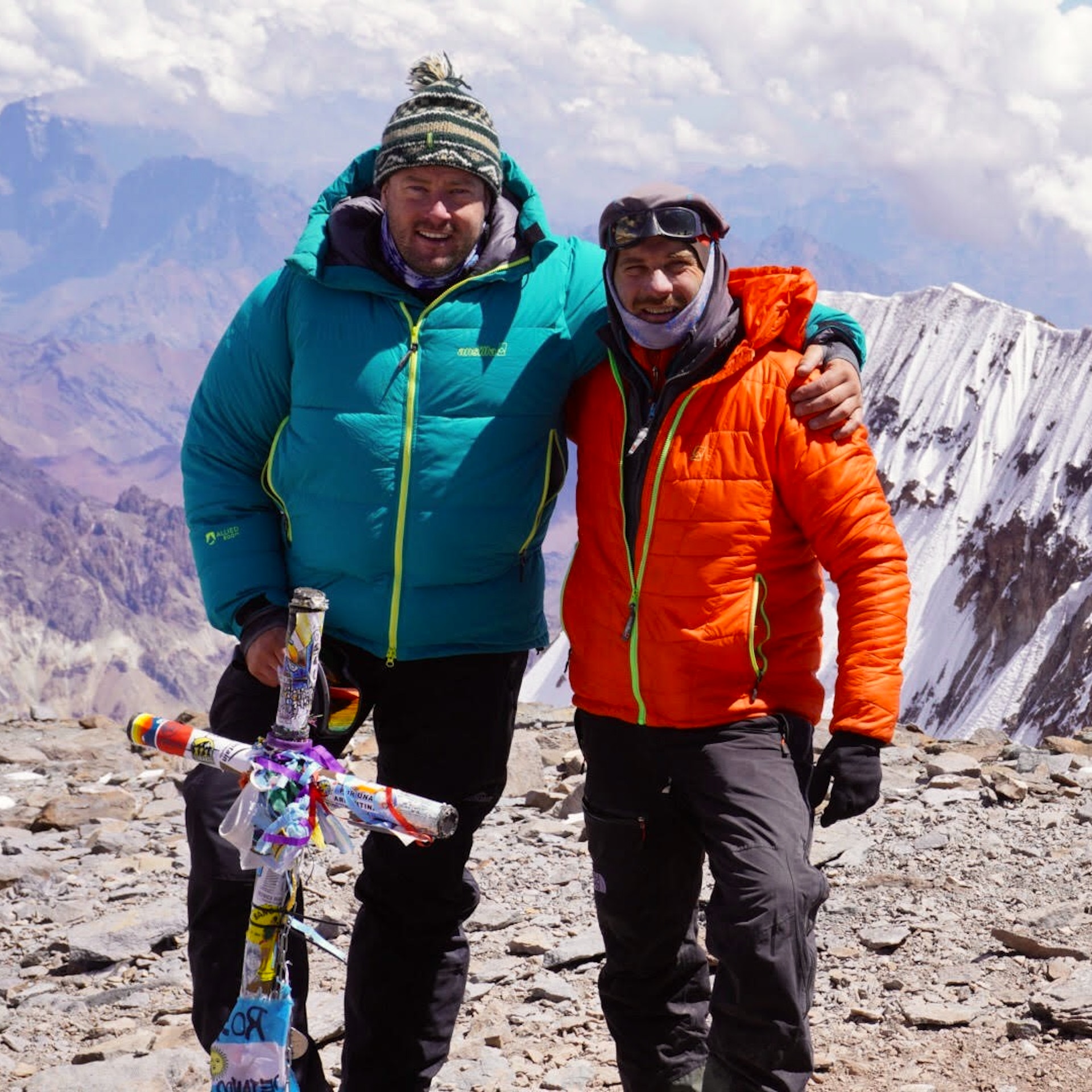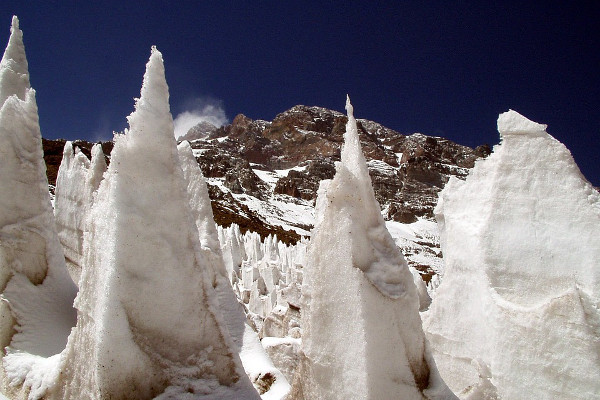Mount Aconcagua, which in Spanish is Cerro Aconcagua, is in the province of western Mendoza in west-central Argentina, on the border with Chile.
It's the largest mountain outside of Asia and one of the Seven Summits, the largest mountains on each continent (counting Australia and Australasia separately).
Possibly, the name originated from ackon cahuak (“sentinel of stone”) in the native Quechua language.
Aconcagua is an extinct volcano that was active until a minimum of 9.5 million years ago, explaining its height. It has two summits connected by a 0.6 mile ridge known as Cresto del Guanaco. It is one of the Frontal Range rather than the Andes, to whose east it lies.
Climbing the mountain will require on average around 21 days.
In this article we have provided some cool Aconcagua facts.

Join an Aconcagua Climb
Book with our recommended local guide
Aconcagua Facts
Geography
The precise height of Aconcagua has been debated since the beginning of the last century.
In 1898, the Chilean Border Committee plumped on 22,830 feet while the Argentine Committee declared it to be 23,390 feet. The Military Geographical Institute of Argentina gives the height as 22,831 feet above sea level, which is now the generally accepted figure.
Aconcaqua is a few hours' travel from the beauteous city of Mendoza to the east and Santiago, Chile, to the west. Mendoza is usually the start and end point for expeditions. It's highly European in appearance, with cafes lining the streets and beautiful plazas all over the place.
The Climb
What is known as the Normal Route isn't technical – just a walk along the Northwest Ridge. Neither the the Normal nor the Polish Traverse routes feature year-round snow fields, but crampons and ice axes may be called for at some points. If you're lucky, the last 1,000 feet will be covered in snow and you can crampon up much more easily than if it were loose scree after a dry winter.
There are severe winds and low temperatures, but it's Aconcagua's altitude that presents the greatest problem. The traditional remedy for altitude sickness is diamox, which helps the body to raise its blood oxygenation levels.
Every year sees an average of three deaths on Aconcagua – mainly people who underestimated their task. Mendoza's police department supplies a rescue team. It doesn't cover routes on the South Wall or Polish Glacier, as they're too risky. Help may take several hours to arrive.
History
Incas reached the top of many high mountains in the Andes – a well-preserved mummy was discovered 17,060 feet up on the Southwest Ridge of Cerro Pyramidal, a sub-peak, in 1982.
In 1947 the remains of a guanaco were found, a humpless camel, between the two summits, which is thought to have been a sacrifice – this is what gave us the name, Cresto del Guanaco.
In 1883, the first known attempt on the highest of Aconcagua's two summits, at 32°39'12.35"S, 70° 0'40.00"W, was by the German explorer, Paul Güssfeldt, who is credited with discovering the mountain. He made it to 21,520 feet but turned back in the face of a hurricane.
It was Matthias Zurbriggen, who was Swiss, who first reached the higher peak in 1897. He was part of Briton Edward Fitzgerald's expedition, which used what is now the Normal Route, on the northwest side of the mountain. Fitzgerald himself turned back at 21,980 feet owing to altitude sickness. Zurbriggen was Fitzgerald's chief guide and could boast of numerous first ascents.
In 1934 a second path was pioneered by a Polish team, today termed the Polish Glacier route.
The fastest ascent and descent was made by the Spaniard, Kilian Jornet, in 2014: 12 hours and 49 minutes. This was his second attempt, the first being put paid to by bad weather. Update: Karl Egloff now holds the fastest ascent record at 11 hours and 52 minutes.
The first woman to climb the mountain was Adrienne Bance of France on March 7 1940. She died on the way down.
The oldest man ever to reach the summit was Scott Lewis in 2007 at the age of 87. The oldest woman was 65-year-old Carol Masheter of the United States in 2012. She remarked, “I should be learning how to knit and play bridge and doing things that are more age appropriate to people my age, but that’s just not me.”
The youngest climber was nine-year-old Tyler Armstrong from the United States, having trained twice a day for six months. His father insisted that it was Tyler's idea and not his. In 2009, the first disabled people to get to the top were five Colombians, four of whom were once soldiers and all the victims of mines.
Fines and ... Y'know
You'll attract a fine of $100 if you deposit rubbish, enter with a bicycle or pet or damage wildlife, plants or cultural or archaeological features. The fine goes up to $200 if you gather or burn wood or carve inscriptions on stones. You will have to pay for another one if you exceed the stay given on your Aconcagua permit (the maximum is 20 days) or climb higher than 4,300 metres.
You have to defecate in a bag, which is supplied. If you lose it, you'll be subject to a $200 fine. If you are spotted “making other arrangements,” the fine is $100. The plastic of the bag is not thick, so it should be double- or triple-packed to avoid the worst form of leakage in the world in your backpack.
The best approach is to do your business in smaller bags and place these in the sh** bag. Your mule provider is responsible for your bag and won't sign your permit if you lose it. There are flushing toilets at Casa Piedra, Pampa Lena and Plaza Argentina but not in the upper camps.
These days, around 3,500 climbers tackle Aconcagua each year, with 60 percent succeeding. 25 percent are Argentinian. The largest contingent hails from the United States.
More Aconcagua articles:
- When is the Aconcagua climbing season
- Insurance for Aconcagua
- How high is Aconcagua
- Aconcagua guidebooks
- Best time to climb Aconcagua
- Aconcagua difficulty
- Hikes in Argentina
Tags: Aconcagua facts, Facts about Aconcagua, Aconcagua facts and history, Mt Aconcagua facts
References: (1) Trail guides, (2) Personal experience, (3) Wikipedia


What is the nationality of 87 year old Scott Lewis who climbed Aconcagua on November 26th 2007?
Thanks in advance
Hi Rene, I’m not 100% sure, but I think American.
Certainly enjoyed my summit of Acocaqua nearly 20 years ago..
Wonder what happens/ ed to signed T shirts left in ‘hotel’ near base camp.
Hope these remain there but guess there is limit.
Dear Andrew:
I shared information from your article with a friend, and he responded: “Aconcagua is 43,000 miles long and 310 miles wide? The Earth is only 24,901 miles in circumference. I’m thinking they put the length at 7000 meters and a width of 500 meters, but it got misread as kilometers and then translated to miles. I’m surprised that nobody has caught that.”
Can you offer any clarification? Thanks!
Hi Peter, that was a definite type, thanks for the heads up. We’re not actually sure of the length and width of the mountain so we have removed this fact for now. If we get any accurate data we will update the article. Cheers!
Dear Mark: Thanks for your follow-up! Best wishes, P.